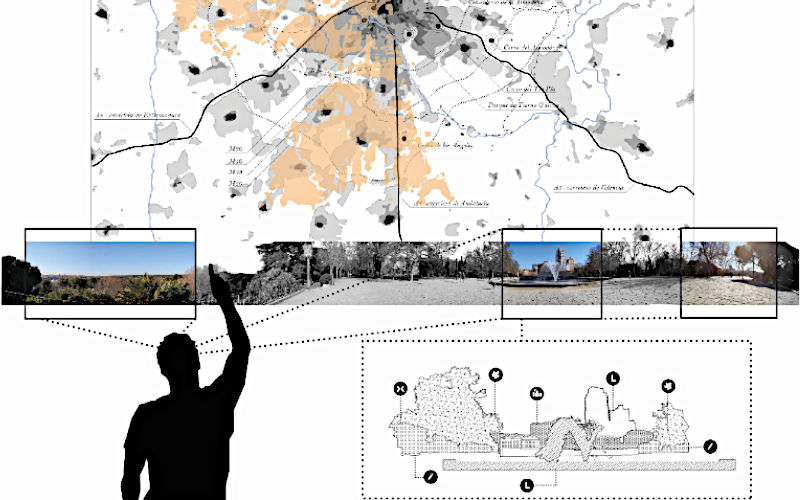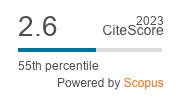Landscape Perception in Peri-Urban Areas: an Expert-Based Methodological Approach
DOI:
https://doi.org/10.3097/LO.201975Keywords:
Landscape Perception, Peri-Urban Landscape, Visualization Tools, Lookouts, RoadsAbstract
While there is general consensus on the importance of landscape perception in urban studies, there is still a need to broaden the toolkit for researchers and practitioners to document, analyse and interpret these inputs, in line with the postulates of the European Landscape Convention and overcoming conventional formats based on descriptions and static photography. This becomes particularly pertinent in the peri-urban landscapes of large cities, bearers of the relations and contradictions between urban growth, resource consumption and landscape protection, and especially vulnerable to tabula rasa approaches. We case study the surrounding landscapes of Madrid at a metropolitan scale, addressing the gap between scopes and scales of recent landscape reports and focusing on two elements connecting (visually, or physically) the city with its commuting zone: lookouts and roads. An expert-based methodology presents the criteria for their selection and a description of desk and field work. A sample for each local approach is further developed to exemplify the application, combining cartography, 3D modelling, visual basins, on-site photography and interpretive drawings. This results in a multifaceted vision of how the city and its hinterland is perceived, illustrating both outstanding and everyday landscapes and how they interweave in a continuous experience.
References
Allen, A. (2003). Environmental planning and management of the peri-urban interface: Perspectives on an emerging field. Environment and Urbanization, 15(1), 135-148. doi:10.1630/095624703101286402 DOI: https://doi.org/10.1177/095624780301500103
Allen, A., da Silva, N. L. A., & Corubolo, E. (1999). Environmental problems and opportunities of the peri-urban interface and their impact upon the poor. Environmental Problems and Opportunities of the Peri-Urban Interface and their Impact upon the Poor
Antrop, M. (2000). Background concepts for integrated landscape analysis. Agriculture, Ecosystems and Environment, 77(1-2), 17-28. doi:10.1016/S0167-8809(99)00089-4 DOI: https://doi.org/10.1016/S0167-8809(99)00089-4
Antrop, M. (2005). Why landscapes of the past are important for the future. Landscape and Urban Planning, 70(1-2), 21-34. doi:10.1016/j.landurbplan.2003.10.002 DOI: https://doi.org/10.1016/j.landurbplan.2003.10.002
Appleton, J. (1975). The experience of landscape. Landscape Research, 1(10), 15-16. DOI: https://doi.org/10.1080/01426397508705780
Azagra Ros, J., Mas Ivars, M., & Goerlich Gisbert, F. (2006). La Localización De La Población Española Sobre El Territorio.Un Siglo De Cambios: Un Estudiobasadoen Series Homogéneas (1900-2001) (the Location of Spanish Population Over the Territory.A Century of Changes: A Study Based on Homogeneous Seri(TRUNCATED)
Banham, R. (1971). Los angeles: The architecture of four ecologies. Los Angeles: The Architecture of Four Ecologies
Berger, A. (2006). Drosscape: Wasting land in urban americ. Princeton Architectural Press, New York
Carrus, G., Scopelliti, M., Lafortezza, R., Colangelo, G., Ferrini, F., Salbitano, F., . . . Sanesi, G. (2015). Go greener, feel better? the positive effects of biodiversity on the well-being of individuals visiting urban and peri-urban green areas. Landscape and Urban Planning, 134, 221-228. doi:10.1016/j.landurbplan.2014.10.022 DOI: https://doi.org/10.1016/j.landurbplan.2014.10.022
Chatel, C., Morillas-Torné, M., Esteve, A., & Martí-Henneberg, J. (2017). Patterns of population and urban growth in southwest europe: 1920-2010. Journal of Urban History, 43(6), 1021-1040. doi:10.1177/0096144217726974 DOI: https://doi.org/10.1177/0096144217726974
Coles, R., Millman, Z., & Flannigan, J. (2013). Urban landscapes - everyday environmental encounters, their meaning and importance for the individual. Urban Ecosystems, 16(4), 819-839. doi:10.1007/s11252-013-0327-y DOI: https://doi.org/10.1007/s11252-013-0327-y
Conisbee, M., Kjell, P., Oram, J., Palmer, J. B., Simms, A., & Taylor, J. (2004). Clone Town Britain: The Loss of Local Identity on the Nation's High Streets
Cruz, L., & Español, I. (2009). El paisaje. de la percepción a la gestión (landscape. from perception to management). Enrahonar: An International Journal of Theoretical and Practical Reason, (45), 179.
Cullen, G. (1971). The Concise Townscape
Daniel, T. C. (2001). Whither scenic beauty? visual landscape quality assessment in the 21st century. Landscape and Urban Planning, 54(1-4), 267-281. doi:10.1016/S0169-2046(01)00141-4 DOI: https://doi.org/10.1016/S0169-2046(01)00141-4
Davenport, M. A., & Anderson, D. H. (2005). Getting from sense of place to place-based management: An interpretive investigation of place meanings and perceptions of landscape change. Society and Natural Resources, 18(7), 625-641. doi:10.1080/08941920590959613 DOI: https://doi.org/10.1080/08941920590959613
De Certeau, M. (1990). L'Invention Du Quotidien
Devine-Wright, P. (2013). Explaining "NIMBY" objections to a power line: The role of personal, place attachment and project-related factors. Environment and Behavior, 45(6), 761-781. doi:10.1177/0013916512440435 DOI: https://doi.org/10.1177/0013916512440435
Español Echániz, I. (2010). El paisaje como nuevo paradigma de la sostenibilidad. Fabrikart, 9, 104-115.
Gallardo, M., & Martínez-Vega, J. (2016). Three decades of land-use changes in the region of madrid and how they relate to territorial planning. European Planning Studies, 24(5), 1016-1033. doi:10.1080/09654313.2016.1139059 DOI: https://doi.org/10.1080/09654313.2016.1139059
García, S. M. P. (2010). Methodological approach to the sights of towns: The case of vélez-málaga
Giné, D. S. (2018). A renewed approach to the ABC landscape assessment method: An application to muntanyes d'ordal, barcelona metropolitan area. Landscape Online, 56, 1-13. doi:10.3097/LO.201856 DOI: https://doi.org/10.3097/LO.201856
Greenbie, B. B. (1982). The landscape of social symbols. Landscape Research, 7(3), 2-6. doi:10.1080/01426398208706035 DOI: https://doi.org/10.1080/01426398208706035
Hernández Aja, A., Rodríguez Alonso, R., Rodríguez Suáres, I., Gómez Jiménez, J. M., González García, I., Córdoba Hernández, R., . . . Jaramillo Cáceres, S. (2018). Barrios Vulnerables De Las Grandes Ciudades Españolas.1991/2001/2011
Hopper, D. (1961). Double Standard.the Dennis Hopper Trust, MoMA
Jackson, J. (2011). Las Carreteras Forman Parte Del Paisaje, , 47.
Jackson, J. B. (1984). Discovering the Vernacular Landscape
Jones, C. D., Patterson, M. E., & Hammitt, W. E. (2000). Evaluating the construct validity of sense of belonging as a measure of landscape perception. Journal of Leisure Research, 32(4), 383-395. doi:10.1080/00222216.2000.11949922 DOI: https://doi.org/10.1080/00222216.2000.11949922
Jones, P., & Burwood, D. (2011). Cycling and the city: Reflections of commuting practices. Liminalities: A Journal of Performance Studies, 7(4)
Jones, P., & Evans, J. (2012). Rescue geography: Place making, affect and regeneration. Urban Studies, 49(11), 2315-2330. doi:10.1177/0042098011428177 DOI: https://doi.org/10.1177/0042098011428177
Jones, P., Isakjee, A., Jam, C., Lorne, C., & Warren, S. (2017). Urban landscapes and the atmosphere of place: Exploring subjective experience in the study of urban form. Urban Morphology, 21(1), 29-40.
Kagan, R. L. (1986). Philip II and the art of the cityscape. Journal of Interdisciplinary History, 17(1), 115-135. DOI: https://doi.org/10.2307/204127
Kaplan, S., & Kaplan, R. (1982). Humanscape: Environments for People
Kargon, J. (2014). One city's 'urban cosmography'. Planning Perspectives, 29(1), 103-120. doi:10.1080/02665433.2013.860880 DOI: https://doi.org/10.1080/02665433.2013.860880
Larrère, C., & Larrère, R. (1997). Du bon usage de la nature. Du Bon Usage De La Nature.Pour Une Philosophie De l'Environnement DOI: https://doi.org/10.1016/S1240-1307(97)81559-2
Lynch, K. (2001). The Image of the City
Martí Marí, S. (2014). This is not land art_ paisajesconducidos (this is not land art_driven landscapes). Ausart Aldizkaria.Revista Para La Investigación En Arte, 2(2), 161-174.
Merriman, P. (2009). Automobility and the geographies of the car. Geography Compass, 3(2), 586-599. doi:10.1111/j.1749-8198.2009.00219.x DOI: https://doi.org/10.1111/j.1749-8198.2009.00219.x
Merriman, P. (2008). Driving spaces: A cultural-historical geography of england's M1 motorway. Driving spaces: A cultural-historical geography of england's M1 motorway (pp. 1-305) doi:10.1002/9780470762448 DOI: https://doi.org/10.1002/9780470762448
Milcu, A. I., Sherren, K., Hanspach, J., Abson, D., & Fischer, J. (2014). Navigating conflicting landscape aspirations: Application of a photo-based Q-method in transylvania (central romania). Land use Policy, 41, 408-422. doi:10.1016/j.landusepol.2014.06.019 DOI: https://doi.org/10.1016/j.landusepol.2014.06.019
Naredo, J. M., & Frías, J. (2003). El metabolismo económico de la conurbación. Economía Industrial, (3), 87-114.
Negussie, E., & Fernández-Salinas, V. (2013). Impact of the cajasol (pelli) tower on the skyline of seville. CIVVIH Newsletter, 20, 15-16.
Ode, A., Fry, G., Tveit, M. S., Messager, P., & Miller, D. (2009). Indicators of perceived naturalness as drivers of landscape preference. Journal of Environmental Management, 90(1), 375-383. doi:10.1016/j.jenvman.2007.10.013 DOI: https://doi.org/10.1016/j.jenvman.2007.10.013
OECD. (2013). Definition of functional urban areas (FUA) for the OECD metropolitan database. Definition of Functional Urban Areas (FUA) for the OECD Metropolitan Database
Palang, H., Spek, T., & Stenseke, M. (2011). Digging in the past: New conceptual models in landscape history and their relevance in peri-urban landscapes. Landscape and Urban Planning, 100(4), 344-346. doi:10.1016/j.landurbplan.2011.01.012 DOI: https://doi.org/10.1016/j.landurbplan.2011.01.012
Piorr, A., Ravetz, J., & Tosics, I. (2011). Peri-urbanisation in europe: Towards european policies to sustain urban-rural futures. Peri-Urbanisation in Europe: Towards a European Policy to Sustain Urban-Rural Futures
Qviström, M. (2010). Shadows of planning: On landscape/planning history and inherited landscape ambiguities at the urban fringe. Geografiska Annaler, Series B: Human Geography, 92(3), 219-235. doi:10.1111/j.1468-0467.2010.00349.x DOI: https://doi.org/10.1111/j.1468-0467.2010.00349.x
Qviström, M., & Saltzman, K. (2006). Exploring landscape dynamics at the edge of the city: Spatial plans and everyday places at the inner urban fringe of malmö, sweden. Landscape Research, 31(1), 21-41. doi:10.1080/01426390500448534 DOI: https://doi.org/10.1080/01426390500448534
Riechers, M., Noack, E. M., & Tscharntke, T. (2017). Experts’ versus laypersons’ perception of urban cultural ecosystem services. Urban Ecosystems, 20(3), 715-727. doi:10.1007/s11252-016-0616-3 DOI: https://doi.org/10.1007/s11252-016-0616-3
Rodríguez Romero, E. J., & Sáenz De Tejada Granados, C. (2017). Entre la ciudad y el campo. evolución de la forma urbana en el noroeste de madrid (between city and countryside. evolution of the urban form in the northwest of madrid). Forma Urbana: Pasado, Presente y perspectivasActas Del I Congreso ISUF-H (Urban Form: Past, Present and Perspectives Proceedings of I Hispanic International Seminar of Urban Form), , 626-633.
Sanz Herráiz, C., & Mata Olmo, R. (2010). Atlas De Los Paisajes De España (Atlas of Spanish Landscapes)
Serrano Giné, D. (2015). Suburban landscape assessment applied to urban planning. case study in barcelona metropolitan region. [Valoración escénica de paisaje periurbano con utilidad en planeamiento territorial. Estudio de caso en la Región Metropolitana de Barcelona] Investigaciones Geograficas, 2015(88), 109-121. doi:10.14350/rig.45090 DOI: https://doi.org/10.14350/rig.45090
Sheller, M., & Urry, J. (2006). The new mobilities paradigm. Environment and Planning A, 38(2), 207-226. doi:10.1068/a37268 DOI: https://doi.org/10.1068/a37268
Smithson, R. (1967). Monuments of Passaic, James Cohan Gallery
Spinney, J. (2009). Cycling the city: Movement, meaning and method. Geography Compass, 3(2), 817-835. doi:10.1111/j.1749-8198.2008.00211.x DOI: https://doi.org/10.1111/j.1749-8198.2008.00211.x
Thrift, N. (2004). Driving in the city. Theory, Culture & Society, 21(5), 41-59. doi:10.1177/0263276404046060 DOI: https://doi.org/10.1177/0263276404046060
Tudor, C. (2014). An approach to landscape character assessment. An Approach to Landscape Character Assessment
Tveit, M., Ode, Å., & Fry, G. (2006). Key concepts in a framework for analysing visual landscape character. Landscape Research, 31(3), 229-255. doi:10.1080/01426390600783269 DOI: https://doi.org/10.1080/01426390600783269
Urbano López, B. (2013). Naturación urbana, un desafío a la urbanización (urban greening, a challengeforurbanization) chapingo, serie. Ciencias Forestales y Del Ambiente, 19, 225-236. DOI: https://doi.org/10.5154/r.chscfa.2013.01.004
van Auken, P. M., Frisvoll, S. J., & Stewart, S. I. (2010). Visualising community: Using participant-driven photo-elicitation for research and application. Local Environment, 15(4), 373-388. doi:10.1080/13549831003677670 DOI: https://doi.org/10.1080/13549831003677670
Van Der Host, D., & Lozada-Ellison, L. M. (2010). Conflictos entre las energias renovables y el paisaje: Siete mitos y la propuesta de manejo adaptativo y colaborativo. Meteorologia Y Paisaje, 25(26), 231-251.
Venturi, R., Brown, D. S., & Izenour, S. (1977). Learning from Las Vegas
Wagstaff, D. J. (1966). Talking with Tony Smith, A r t f o r u m
Wester-Herber, M. (2004). Underlying concerns in land-use conflicts - the role of place-identity in risk perception. Environmental Science and Policy, 7(2), 109-116. doi:10.1016/j.envsci.2003.12.001 DOI: https://doi.org/10.1016/j.envsci.2003.12.001
Zárate Martín, M. A. (2011). Paisajes culturales urbanos, entre la protección y la destrucción. Boletín De La Asociación De Geógrafos Españoles, 57(57), 175-194.
Zoido Naranjo, F. (2002). El paisaje y su utilidad para la ordenación del territorio. Paisaje y Ordenación Del Territorio, , 21-32.
Zube, E. H., & Pitt, D. G. (1981). Cross-cultural perceptions of scenic and heritage landscapes. Landscape Planning, 8(1), 69-87. doi:10.1016/0304-3924(81)90041-1 DOI: https://doi.org/10.1016/0304-3924(81)90041-1
Zube, E. H., Sell, J. L., & Taylor, J. G. (1982). Landscape perception: Research, application and theory. Landscape Planning, 9(1), 1-33. doi:10.1016/0304-3924(82)90009-0 DOI: https://doi.org/10.1016/0304-3924(82)90009-0

Downloads
Published
How to Cite
Issue
Section
License
Copyright (c) 2019 Eva J. Rodríguez Romero, Carlota Sáenz de Tejada Granados, Rocío Santo-Tomás Muro

This work is licensed under a Creative Commons Attribution 4.0 International License.










